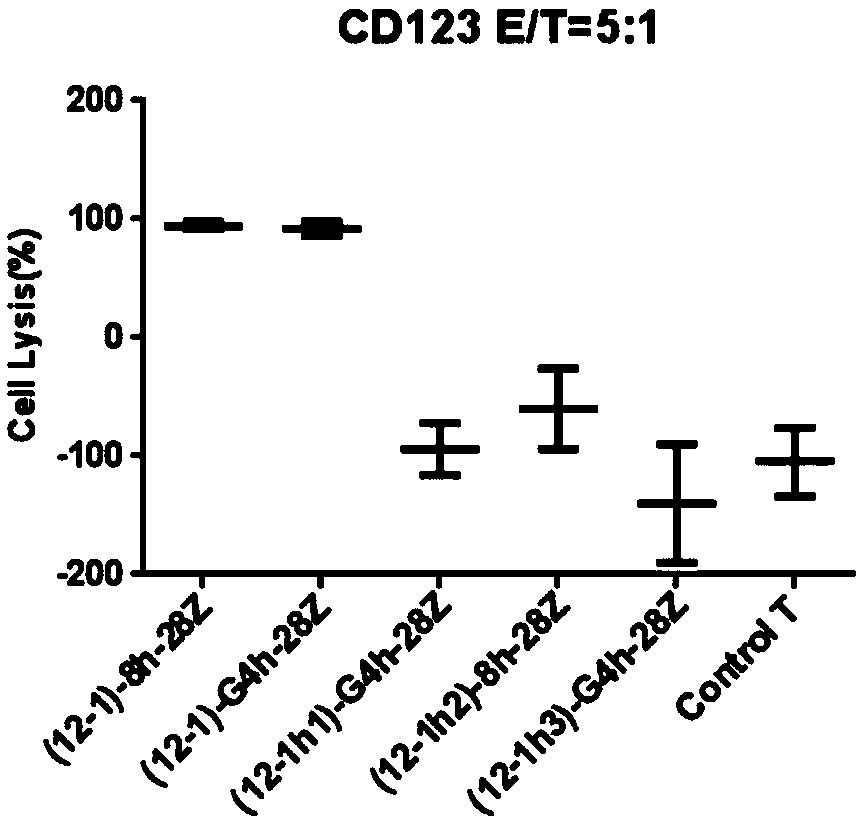Chimeric antigen receptor of anti-human CD123 and application of chimeric antigen receptor
A chimeric antigen receptor and antigen technology, applied in the field of genetic engineering, can solve the problem of loss of antigen-binding activity of antibodies, achieve the effects of no toxic side effects, reduce immunogenicity, and enhance sustainability and safety
- Summary
- Abstract
- Description
- Claims
- Application Information
AI Technical Summary
Problems solved by technology
Method used
Image
Examples
Embodiment 1
[0048] Example 1: Design of humanized monoclonal antibodies against human CD123 antigen
[0049] (1) The amino acid sequences of the 6 FR regions of the light and heavy chains of the mouse anti-human CD123 monoclonal antibody were analyzed and compared through the IMGT / BLAST database, and the human antibody sequence with the highest homology was selected as the transformation template. The murine antibody scFv sequences are shown in Table 1 below.
[0050] Table 1: Murine Antibody scFv Sequences
[0051]
[0052] (2) After molecular docking simulation, the backbone sequence was humanized and modified to obtain 3 humanized scFvs, the amino acid sequences of which are shown in SEQ ID NO.1, SEQ ID NO.2 and SEQ ID NO.3. CAR construction was carried out, and it was verified that although the CAR constructed by the humanized scFv can be normally expressed on the surface of T cells, none of them can work normally, while the CAR of the unmodified mouse scFv combination can work no...
Embodiment 2
[0054] Example 2, Affinity Determination of Humanized Monoclonal Antibody Targeting CD123
[0055] The preferred monoclonal antibody scFv is tagged with His tag and cloned into a plasmid vector and transfected into HEK293 cells, scFv-His is purified, scFv-His and the negative control are diluted in 6 gradients with PBS, and CD123-positive THP-1 cells are incubated respectively, The positive rate of THP-1CD123 detection under the concentration gradient was detected by flow cytometry, and the positive rate of flow cytometry and MFI (mean fluorescence intensity) were counted, and the affinity of different scFvs to CD123 was analyzed. The experiment was repeated three times independently, and the results were as follows: image 3 As shown, the larger the Kd (nM), the smaller the affinity.
Embodiment 3
[0056] Example 3. Preparation of Lentivirus Expressing a Chimeric Antigen Receptor Targeting Human CD123 Antigen
[0057] (1) Prepare the gene sequence of the chimeric antigen receptor targeting human CD123 antigen
[0058] Synthesize chimeric antigen receptor sequence containing leader peptide (also known as signal peptide), anti-human CD123 antigen single-chain antibody ScFv, hFc hinge region, transmembrane region and intracellular signal segment in sequence, its structure is as follows Figure 4 shown. The nucleotide sequence of the leader peptide is atgggatggagctgtatcatcctcttcctggtagcaacagctacaggcgtgcacagt; the nucleotide sequence of the humanized single-chain antibody against human CD123 antigen is as SEQ ID NO.18, SEQ ID NO.19, SEQ ID NO20, SEQ ID NO21, SEQ ID NO22, SEQ ID NO22, SEQ ID NO. ID NO23 and SEQ ID NO24; the nucleotide sequence of the hFc hinge region is an amino acid sequence such as the amino acid sequence corresponding to SEQ ID NO.8 or SEQ ID NO9 or SEQ ID...
PUM
 Login to View More
Login to View More Abstract
Description
Claims
Application Information
 Login to View More
Login to View More - R&D
- Intellectual Property
- Life Sciences
- Materials
- Tech Scout
- Unparalleled Data Quality
- Higher Quality Content
- 60% Fewer Hallucinations
Browse by: Latest US Patents, China's latest patents, Technical Efficacy Thesaurus, Application Domain, Technology Topic, Popular Technical Reports.
© 2025 PatSnap. All rights reserved.Legal|Privacy policy|Modern Slavery Act Transparency Statement|Sitemap|About US| Contact US: help@patsnap.com



